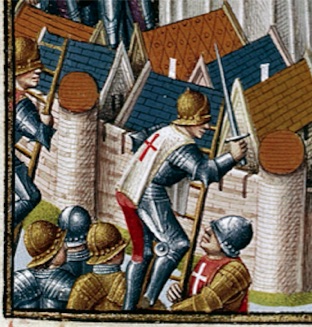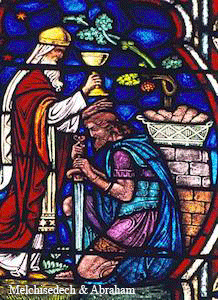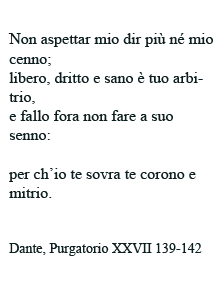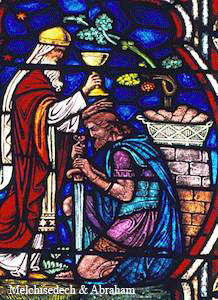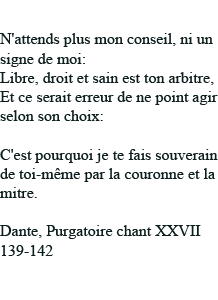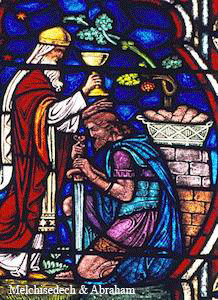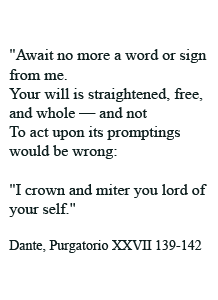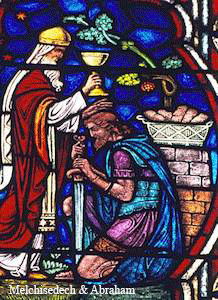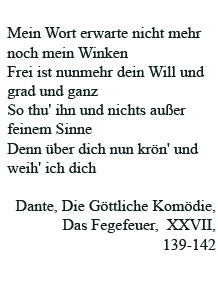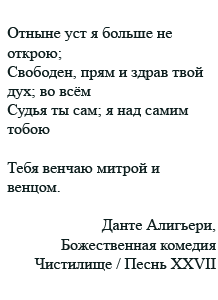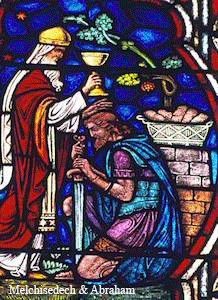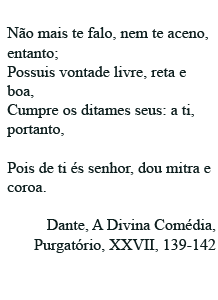Mary, the woman with twelve stars
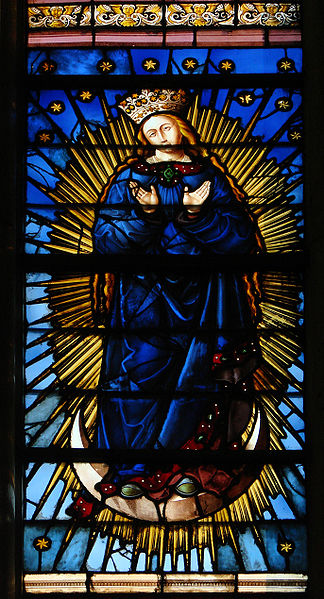
And a great sign appeared in heaven: A woman clothed with the sun, and the moon under her feet, and on her head a crown of twelve stars. (Apocalypse, 12,1)
A better understanding of Marian spirituality requires getting familiar with the 'angelic language' spoken by the monks. Monastic life is an angelic life and, by making the vows of chastity, poverty and obedience, by sharing the common life, the monks aim to gain access to the angelic status. The angelic language is not Latin as one might think but a more ancient and universal one, in which the science of the stars combines with the art of the surveyor .
In the Middle Ages, this science was part of the quadrivium, the section of the liberal arts which comprised astronomy, geometry, arithmetic and music. This 'bread of the angels' may seem surprising to many readers, and even a little indigestible. It is however a requisite for all those who wish to approach Mary and hear her child proclaim "Ego sum lux mundi," "I am the light of the world."
Mary, clothed with the sun
The Cistercian and Templar churches, like all sacred architectures, are designed in relation to celestial events, the main reference points for the orientation of a building being the spring equinox (around March 21), and the summer solstice and winter (around June 21 and December 21).
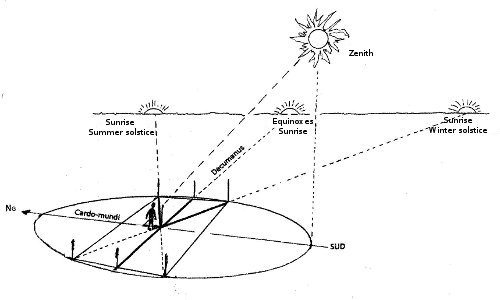
diagram from the book by Philip Andreoli, The Origins of the Tradition, website: www.saint-bertrand-symbolique.com
The art of the surveyor was to determine the orientation of the future church in relation to the Sun, image of Christ the Savior. Using his knotted rope, he traced a circle on the ground, and after applying lime on its circumference, marked the different positions of the sunrises and sunsets at the solstices and equinoxes.
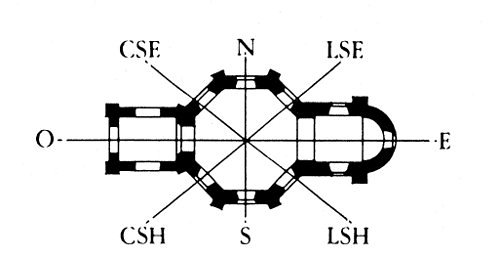
Plan of the Templar church of Laon, dedicated to St. John the Baptist, observation of the equinoxes and of the sunrises and sunsets of the summer and winter solstices viewed from the keystone of the church bearing the Agnus Dei.
A strong symbol of the surveyor's art in the Middle Ages was the chrismon, which the companions preferred to bear in the form of a six-pointed star.
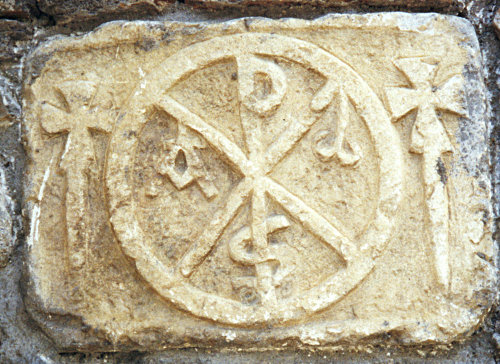
The chrismon, or Chi-Rho, is the monogram of Christ formed by superimposing the Greek letters 'x' (chi) and 'p' (rho). Often the letters alpha and omega, first and last letters of the Greek alphabet are also present on the monogram - in reference to the Revelation of St. John 1.17: “Fear not; I am the first and the last, and the Living one; and I was dead, and behold, I am alive for evermore, and I have the keys of death and of Hades.”
From the eleventh century, the letter 's' was added to the monogram to signify the Holy Trinity: the Father at North, the Son, 'x', alpha and omega, in the center, and the Holy Spirit at South. The alpha is placed at the sunset at the winter solstice, the 'first' beginning with the end of the shortest day of the year, and the omega is set at sunrise at the summer solstice, the 'last' ending with the sunrise on the longest day of the year.
In Christian tradition, the two solstices are also associated with the two Saints John - the winter solstice is associated with Saint John the Evangelist, whose feast day is on December 27, and the summer solstice with St. John the Baptist, whose feast day is on June 24 .
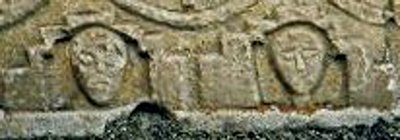
In the chrismon symbolism, Saint John Baptist closes the solar cycle. He is regarded in the Middle Ages as the last figure of the Old Testament, and Mary, the mother of Jesus, as the one who opens the New Testament.
In the Cistercian order and according to the statutes of the Benedictine Strict Observance, all the churches of their monasteries were to be dedicated to the Virgin Mary. Laurent Dailliez wrote in his Guidebook to Templar France:
"It is the same issue concerning the orientation of churches. Why should we want to believe the Knights Templar were Johannists or following any rite whatsoever on the basis of the orientation of their churches? The same could be said of the Cistercians. The Templar churches are all correctly oriented on the first ray of sunshine on The apse of a church in the Middle Ages, according to the terms of the symbolism of the time, wasn't oriented on the sunrise but on the angle of arrival of the light. The master-builder did not only base himself on the geographical environment, but also on the angle formed by the East and the axis of the first ray of sunshine. During construction, the master-builder took into account astrology and what we now call the declination. " Midsummer.
If we do not share the author's skepticism concerning the Johannic character of the religion of the Knights Templar, his remarks on the master-builders intentions seem interesting. Churches were usually oriented on the spring equinox around March 21. Laurent Dailliez highlights a tradition concerning the Marian churches which were, for their part, directed toward the Midsummer sunrise.
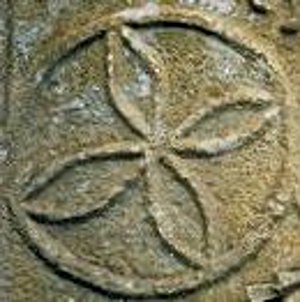
The author also notes that the master-builders took astrology into account in their constructions. If one connects the study of the orientation of Marian churches with astrology as Laurent Dailliez suggests, the summer solstice, linked to the feast of St. John the Baptist on June 24, corresponds to the zodiacal sign of Cancer. In the cosmology of the ancient Roman religion, the Cancer sign is the lowest in the Zodiac and represents the gate of hell. From the summer solstice, around June 21, symbolically associated with the feast of St. John the Baptist, the days become shorter and the nighttime wins over the daytime. St. John Baptist is indeed the patron of the West, the land of the 'setting sun'.
St. Benedict (480-547), declared father of Europe by the Catholic Church, had built his monastery on the Monte Cassino on the ruins of an ancient Roman temple dedicated to Apollo, the god of the sun. In its place, St. Benedict dedicated a chapel devoted to St. John the Baptist.
By turning to St. John the Baptist, Mary, clothed with the Sun , invites us to make a descent into the Hades. In medieval symbolism, Mary and John the Baptist are the two sides of an initiatory journey to reach the home of angels.
Mary, the moon at her feet
The reading of the chrismon, between the alpha and omega, comprises a solar cycle of six months, which begins at sunset at the winter solstice and ends with the sunrise at the summer solstice. The upper part of the chrismon, on the solar side, is governed by the Father. The lower part of the chrismon is the domain of the Moon and is governed by the Holy Spirit.
While it is relatively common to study the symbolism of a church by taking into account the solar quadrangle on a east-west orientation, it is much less frequently approached by the survey of its Lunar quadrangle on the north-south axis.
Philippe Andreoli, in his book The Origins of the Tradition ( www.saint-bertrand-symbolique.com ) studies the orientation of the side entrance of St. Mary's Cathedral in Saint-Bertrand de Comminges which was served by Canons Regular.
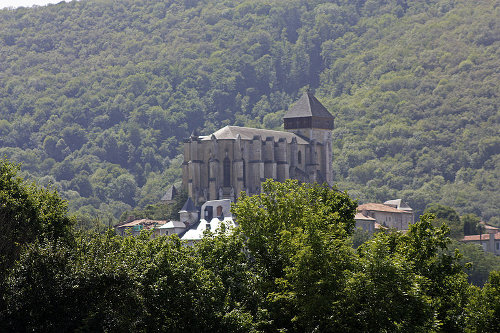
In churches and cathedrals where clerics lived in community, the entrance to church services is was not the main entrance, often located to the west and intended for the general public, but the side entrance opening onto the cloister. This passageway connecting the cloister to the main building was reserved for those who chose to live the common life of monks.
By studying the orientation of the cathedral and its side access, Philippe Andreoli brings to light another orientation of Saint-Mary Cathedral, a secret one, based on the moon rise on the winter solstice:
"We plotted the orientations of the cathedral ( the Romanesque part and the Gothic part) on the basis of the noonday shadows. The cathedral is not aligned with the sunrise at the summer solstice nor with the equinox. The Romanesque square forms an angle of 24 ° 40 with the geographic north, which makes it possible to set straightaway the orientation of the roots of the lunar quadrangle relative to the site of St Bertrand. Bear in mind however that the moonrise/ moonset in this figure are reversed with those of the solar quadrangle. The architect wanted to orientate the root symbolizing the moonrise at the winter solstice on the real direction of the rising sun at St Bertrand on the first day of summer (summer solstice) "
This means the lateral passageway reserved for the canons regulars had a dual orientation: openly oriented on Midsummer, it was therefore also secretly directed on the moon rise at the winter solstice.
A recumbent statue watches over the entrance of the cloister of the cathedral Saint Mary of Saint-Bertrand de Comminges and this tomb is marked by two crosses, reminders of the double orientation of this passageway: over his head there is a cross pattee fitched at foot and at his feet a Greek cross which would have been within the Templar Knights a 'cross of secrecy'

Philip Andreoli's survey on the orientation of the canons regular's passageway in Saint Mary's cathedral brings out the existence of a mysterious moon rise on winter solstice.
In his 'Sermon of the Twelve Stars', St. Bernard associates the moon with the "Prince of all folly," the ancient serpent "that Mary tramples underfoot." He writes:
"Furthermore, this prince of all folly, of unequaled insanity, of which one can truly say he has changed like the moon, and has lost all his brightness, is now trampled, crushed by Mary under whose feet he endures a terrible bondage. For she is the one promised by God to crush some day under the foot of her virtue the head of the ancient serpent. "
Could it be that this passageway leads us straight to the Inferno? The notion of Hell must however be handled with caution. Etymologically, the 'infernal region' is 'the lower region'. For those who live the angelic life, it is rather the worldly things which are designated by this appellation.
“Still, if your consideration so engages in the things below as to seek the things above, it does not stray from its purpose. Consideration thus employed is a returning home. That is a highest and worthiest use of worldly things when, according to the wisdom of Paul, 'God's invisible qualities have been clearly seen, being understood from what has been made' (Rom. I, 20) ” ( Saint Bernard, On Consideration).
Note that the side passageway is located at the south of the cathedral, which in the Trinitarian chrismons is associated with the Holy Spirit. In some chrismons, the 'S' is placed upside down. It has been suggested that in this case it represented the figure of the snake.
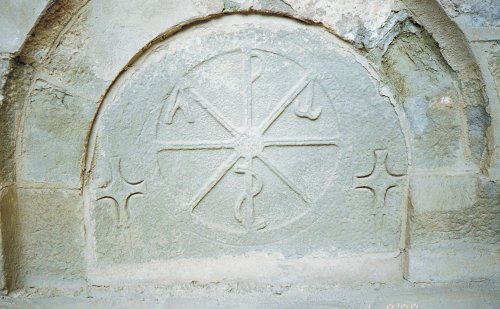
For the canons regular, immersing oneself in the study of the world's symbolic structures is a descent into Hell, but at the end of the night there is the winter solstice - the moment when the light of day overcomes darkness. The bottom of hell is the door that allows the human spirit to rise to the heavens. The winter solstice, which is around the 21st of December, is linked symbolically to St. John the Evangelist, author of the Apocalypse, the Book of Revelation.
The Canons Regular are the ones who introduced the figure known as the Baphomet in the liturgy of the Templars. This figure is the zodiacal representation of the winter solstice.
It has a monstrous aspect. In his testimony during the trial, the Templar Raoul de Guy, recipient of the royal finances for the Province of Champagne, says about it :
“Terrible! It seems to me it was the figure of a demon, of an evil spirit. Every time I looked at it, such a state of terror overwhelmed me that I could barely look at it, trembling in every limb. "
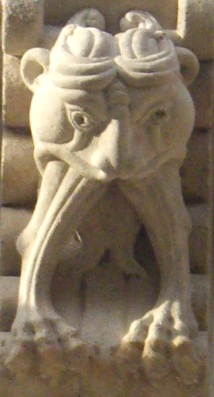
The terrifying aspect of the Baphometic monster is the result of the zodiacal combination of the Goat-Capricorn and the Centaur-Saggitarius which are the two zodiacal signs bordering the winter solstice. It's extreme ugliness is also a warning, a reminder of the limits of symbolic knowledge, as the canon regular Hugh of St. Victor says in his Commentary on the Celestial Hierarchy:
"The Ugly more than the Beautiful proves that visible forms are only a symbol of perfect beauty and not the true Beauty. Physical beauty deceives us since it gives us the illusion of being in possession of the perfect, the Ugly is more truthful because it forces us to desire the infinite beauty that nothing can concretise. "
Mary, the woman crowned with twelve stars
The two analyses of Laurent Dailliez and Philippe Andreoli draw our attention to the link between the churches dedicated to Mary and Midsummer, at the summer solstice, and the one which relates them to the Moon at the winter solstice.
Now we see Mary in a new light, she is 'the woman clothed with the Sun, and the Moon under her feet,' of the Apocalypse (12:1), whom St. Bernard writes about in his Sermon of The Twelve Stars:
"'On her head', we can read, 'was set a crown of twelve stars.' This forehead, brighter than the stars themselves that are adorned by it more than they adorn it, was certainly most worthy to receive such a crown. After all, why wouldn't the stars be the crown of the one for which the Sun itself is the coat? "
These twelve stars can be identified with the twelve signs of the zodiac, which with the sun and the moon, complete the blueprint for reading the architecture of Marian churches.
We believe that the Benedictine monks in order to interpret the Zodiac set a cross of equal arms – the cross of the angels - in the center of the zodiacal circle.
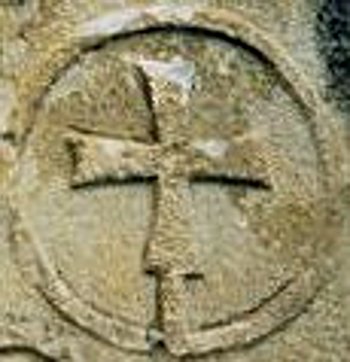
The initials of the cross of St Benedict on the vertical axis: CSSML (= "Crux Sacra Sit Mihi Lux," May the Holy Cross be my Light ") are there to remind us the path to follow. Starting from the Cancer, the sign of the feast of St John the Baptist, we have, facing him, the Capricorn. This sign is the highest in the zodiacal circle. It begins on the day of the winter solstice, which was for the Romans the 'Gate of the Gods'. This time of year marks the reversal of the gradual lengthening of nights and shortening of days, the daylight defeats the darkness, and on that day the soul, after its descent into the material world, starts its spiritual journey back to the Heavens.
On the horizontal axis of the cross of St. Benedict are the initials NDSMD (= "No Draco Sit Mihi Dux", "Let not the Dragon be My Guide").

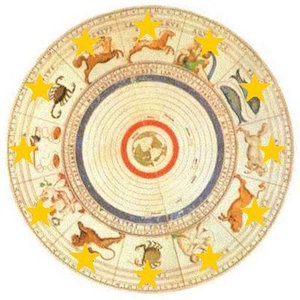
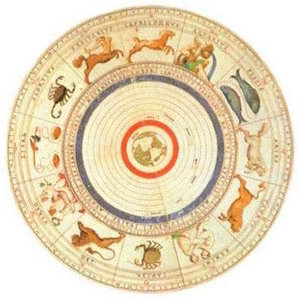
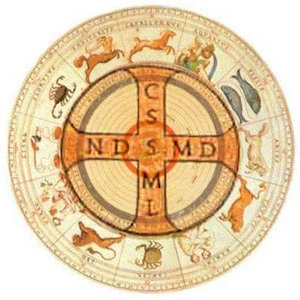
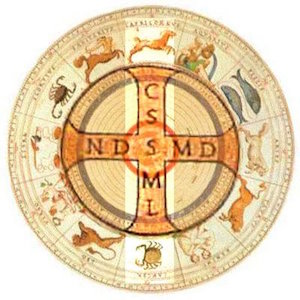
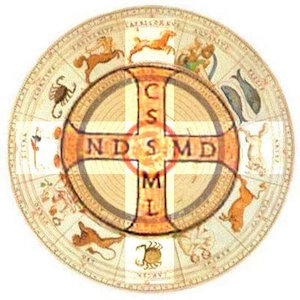
The two signs perpendicular to the vertical axis Cancer-Capricorn are Aries and Libra. These four signs are the cardinal signs of the zodiac in connection with the solstices and equinoxes. With the cross of angels, St John the Baptist shows us the Lamb of God, The Ram (Aries) associated with The Scales (Libra). St. John the Baptist is the Precursor, the one who points to the Lamb of God who will take away the sin of the world.
Mary Star of salvation
The descending and ascending of the spirit is at the heart of the Benedictine contemplative life. In St Benedict's Rule, Jacob's ladder is a recurring theme, as in the following passages:
"Yes, while he slept, Jacob saw the angels descend and ascend along this ladder (Gen 28.12)." (Rule 7.6)
“We may call our body and soul the sides of this ladder (...)" (Rule 7.9)
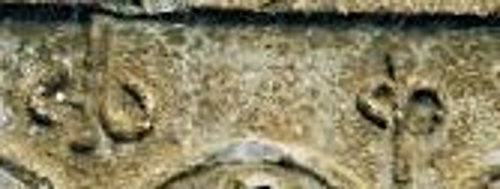
For the Cistercians, it is Mary who ' is the ladder of sinners” and, in his sermon 'On the Aqueduc', St Bernard adds that she is “the whole reason for my hope” . She is the one who opens the door to heaven.
“The citizens, doubtless, have no need of the ladder ; exiles have.”(St. Bernard, From Consideration)
Thanks to Mary, fellow-citizen of the saints and mediator between Heaven and Earth, it is possible to reach to the angels homeland .
"After all, why would you not see an angel whilst you already live as the angels. Why wouldn't an angel pay a call to his companion in life ? And would he not greet the fellow-citizen of the saints, familiar with the house of God? "(St. Bernard, Sermon 'on the Aqueduct ')
It is Mary, the fellow-citizen of the saints, which enables the Benedictine monks of the Strict Observance to reach the 'celestial citizenship' by which, with their mastery of the symbolic structures, they set their temporal acts in harmony with the cosmos.
Mary faces St. John the Baptist. In the symbolic tradition of the Strict Observance, they form an inseparable couple, and Filippo Brunelleschi, architect and inventor of descriptive geometry, who had drawn his knowledge from the Divine Comedy's Inferno of his compatriot Dante, will use the face-to-face between the baptistery of St. John and the cathedral of Santa Maria del Fiore to present his first public experiment on the unified perspective.
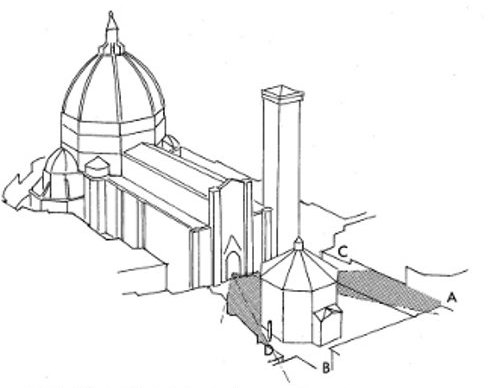
Brunelleschi's first experiment: oblique view of the Cathedral of Santa Maria del Fiore and the Baptistery of St. John showing the position of the observer inside the central portal; in: The Origin of the Perspective Hubert Damisch, ed. Flammarion
The reading of the Acts of the Apostles on the day of the Ascension of Christ which was, let us keep in mind, a high point in the liturgical calendar of the Gregorian church from which the Knights Templar came out from, recalls Christ's words on the Mount of Olives:
"For John baptized with water, but in a few days you will be baptized with the Holy Spirit."
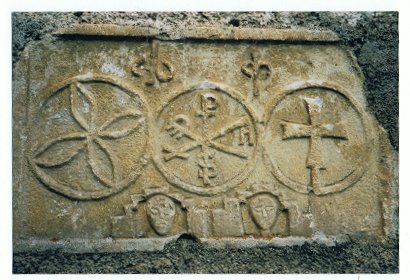
Nurtured by the Ancients secret knowledge, enlightened by the light of salvation, the Gregorian Church strove to implement a new social order , and the figure of Mary contained the essence of this project. She is, to quote St Bernard in his sermon 'On the Aqueduct':
“a garden enclosed, a fountain sealed up; the living temple of the Lord, the sanctuary of the Holy Spirit. Mary is not a foolish virgin. Not only does she have oil, but she has plenty in her vase. (Mt 25, 1-12 )”.
by Jean-Pierre SCHMIT



